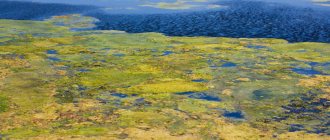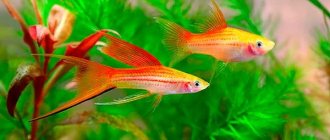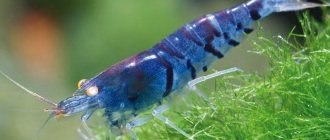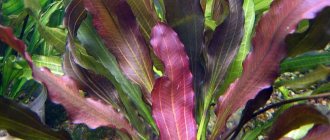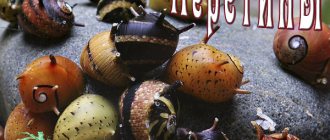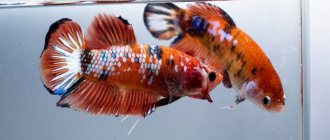§ 33. Features of fish reproduction
Reproductive organs.
Fish are usually dioecious animals. The reproductive organs of females are the ovaries (see Fig. 118, p. 15), in which the eggs - eggs - mature. The reproductive organs of males are the testes (milt). Sperm mature in them.
Reproduction.
Females spawn eggs into the water. Males pour seminal fluid containing sperm onto the eggs. After fertilization - the fusion of a sperm with an egg - fish fry develop from the fertilized egg.
Most often, fish spawn in the water and do not take care of their offspring. With this method of reproduction, a lot of eggs are formed - hundreds, thousands, hundreds of thousands, even millions, since many of them die: some are eaten by predators, others end up in unfavorable conditions, are affected by mold, parasites, or die for other reasons. For example, cod lays up to 10 million eggs. In our country, the most prolific freshwater fish are carp (up to 1.5 million eggs) and pike (up to 1 million eggs).
However, among fish there are also those who take care of their offspring. They lay eggs in depressions on the bottom (salmon), build nests (stickleback - see Fig. 121), carry eggs in their mouths (tilapia) or on their bodies (pipefish, seahorse). Some fish are characterized by viviparity. Among cartilaginous fish, most sharks are viviparous and give birth to young sharks. When caring for offspring, the number of eggs laid by one female and cubs born is reduced to tens and units. In caring for offspring, complex forms of fish behavior are manifested. For example, a male stickleback jealously guards his nest from predators, and a tropical catfish, carrying eggs in its mouth, subsequently allows the fry to hide there if they are in danger.
Rice. 121. Stickleback at the nest
Migrations.
As you know, fish constantly move in the water alone and in groups. Many fish move long distances. Such movements of animals are called migration.
There are feeding migrations. Thus, herrings move in the ocean following the plankton that serves them as food, and sharks follow the herrings and hunt them. Migration associated with reproduction is interesting. The fact is that places with abundant food are often not suitable for fish to reproduce, since eggs must be laid in clean water, rich in oxygen, well warmed by the sun's rays. So the fish move, covering hundreds and even thousands of kilometers, from feeding grounds to spawning (reproduction) places. This is what salmon do in the Far East and northern Europe, and sturgeon in the Caspian Sea. Fish that move from seas to rivers or from rivers to seas are called migratory.
Adult individuals of Far Eastern pink salmon (Fig. 122) after spawning are doomed to death. Their instinct to leave behind offspring is so strong that, going up the rivers, they do not eat anything and come to the spawning grounds exhausted by hunger, lay eggs, fertilize them and die.
Rice. 122. Pink salmon (above) and male pink salmon before spawning
Fish are dioecious animals. They reproduce in water: females lay eggs, males secrete seminal fluid onto the eggs. Most fish lay many eggs and leave them unattended after fertilization. Many eggs die. Fish that care for their offspring have few eggs; most of them successfully develop into fry.
Fish instincts
Fertilization is preceded by a series of events. They are a signal of readiness to reproduce.
Stimulation for mating
Many species approach reproduction very responsibly. Salmonids, for example, migrate from the salty ocean up to freshwater bodies to spawn. They can travel thousands of kilometers, making a dangerous journey up fast rivers, exhausting themselves to the end.
In many cases, males (such as guppies) are brightly colored to attract the female. In a mating dance, they circle around the gray females, trying to attract their attention. The lady will choose which male is the most colorful.
Males of other species can build “houses” from silt, mud and other bottom debris. If the female likes the house, the fish mate.
Certain conditions are required for mating
Features of fish reproduction. Stages of development, direct and indirect development, caring for offspring
Depending on the type of reproduction, fish are divided into egg-laying, ovoviviparous, and viviparous.
Egg-laying fish are the main group of fish that spawn eggs into the water column, where fertilization occurs.
Ovoviviparous - internal fertilization, the embryo develops in the female’s body in special extensions of the oviducts, but is nourished by the nutrients of the yolk sac, and the mother’s body serves only as protection from external factors.
Viviparous - in these fish, the union of the egg and sperm occurs in the female’s genital tract, the formation of the placenta occurs, which ensures the connection of the mother’s body with the embryo and supplies nutrients.
Viviparity is a rare phenomenon, typical for aquarium fish (guppies, swordtails), and sharks. There is no larval stage; an embryo develops in the oviducts of the female, and an already formed fry is born, which is capable of independent existence.
What fish lay eggs in an aquarium?
The fry hatch on the fifth day. And growing them is an even more complicated procedure. Also, eggs are laid by such common species of aquarium fish as bettas, barbs, zebrafish, ancistrus, gourami and many others.
Interesting materials:
Is it possible to freeze at above-zero temperatures? Is it possible to freeze watermelon in the freezer? Can carrot tops be frozen? Can Brioche be frozen? Is it possible to freeze finished baked goods? Is it possible to freeze ready-made cutlets? Is it possible to freeze ready-made cakes? Is it possible to freeze arugula and salad? Is it possible to freeze cooked meatballs? Is it possible to freeze boiled beets?
Features of fish reproduction
Fish are dioecious animals. Females produce eggs - eggs that develop in the ovaries and have a thin, translucent membrane for quick and easy fertilization. Moving along the oviducts, they exit through the external opening located near the anus.
Perch
Males form sperm in paired testes - milk, which is a system of tubules that flow into the excretory duct. There is an expanded part in the vas deferens - this is the seminal vesicle. The laying of eggs and the release of seminal fluid occurs almost simultaneously.
The exception is the rock perch, which has gonads of two sexes, but they do not mature at the same time, which prevents self-fertilization.
Rock Perch
Fish are characterized only by sexual reproduction , through the fusion of male and female reproductive cells.
The process of laying eggs by females and fertilizing them with sperm from males is called spawning . During the spawning period, fish look for favorable conditions for the development of offspring, so they often leave their usual habitats. Some move from the seas to the mouths of the rivers flowing into them, while others, on the contrary, rush to the seas.
If, due to unfavorable conditions, the fish were unable to spawn, they are characterized by resorption of eggs and milt (gradual resorption of the reproductive material).
Fertilization in most cases is external; the larva develops outside the female’s body (live birth is rare).
Fish lay eggs in huge quantities (from 100 thousand to millions of eggs). Such fertility ensures the preservation of the species, because not all eggs will be fertilized, and some will die altogether.
Ciliates
Of the protozoa, ciliates are most often used as food. From school we are familiar with the paramecium slipper. The sizes of ciliates are small, 50-100 microns. They can only be seen under a microscope.
At a temperature of 20-25 °C, paramecium divides 4-5 times a day. Reproducing in this way, it produces an astronomical value in 6 days - 10 billion copies. Ciliates live at temperatures from 0 to 40 °C. They can be cultivated in any containers - barrels, buckets, flasks, etc. The process of planting them begins with adding a portion of 20-30 grams of hay per 1 liter of water.
This mixture is boiled for 20 minutes and then left for 2-3 days. To feed paramecia, feed yeast is first added at the rate of 0.1 g per 1 liter, then milk - 2 ml per 1 liter and 5-10 ml of a three-day infusion from the tops of radishes, carrots or lettuce. The “starter” of the ciliates is introduced from another container with a hay solution (20 g/l of water), infused for 3 days in boiled or tap water in a separate container. It is enough to add a few drops of “starter” per 1 liter of water, so that after 5-6 days the daily production of ciliates is several milligrams per 1 liter of water.
Thus, 8-9 days before receiving one-two-day-old larvae of carp and silver carp, it is necessary to begin preparing live food for their cultivation. Ciliates are brought into a container (baths with a volume of 40 liters are convenient), where the larvae of these fish are kept at an optimal stocking density of 10 thousand pieces. per 1 m3 of water. In the first two days, water flow is not necessary. To aerate the water, if necessary, you can use an aquarium compressor with an air spray.
In the same container, larvae of carp, perch and other fish are grown to a weight of 15 mg, sturgeon - 200, salmon - 300 mg. But for this, rotifers or other food organisms are introduced. Such feed is prepared or specially cultivated.
To collect zooplankton organisms (rotifers, daphnia, moins), one of the most common methods of obtaining live food for larvae and fry is used - filtering water from a pond, lake or other body of water through a plankton mesh. The denser the nylon sieve, the smaller organisms are retained in it. Typically, plankton strained into a bucket is passed through a finer sieve so that large organisms do not reach the larvae.
If there is no large reservoir or watercourse nearby, you can cultivate zooplankton in special containers.
Stages of fish development
When the eggs are spawned, sperm can enter the egg through a special opening called the micropyle. After the fusion of germ cells, the egg membrane becomes more permeable (adsorbs water) and stronger.
After fertilization is completed, a zygote , in which multiple divisions occur to form a multicellular embryo . In the abdominal region, the remains of the yolk sac are preserved, which provides nutrition to the larva in the first days.
The larval stage begins with the rupture of the egg shells, when the formed individual comes out and begins to feed on its own (unicellular organisms, crustaceans, algae). The body shape is elongated, large eyes, and no fins.
In the first days, the larva hangs motionless, attached to some substrate, and after depleting its supply of nutrients, it begins to actively move in search of food. During this period, scales begin to form. Small fish have functioning temporary organs that are needed for survival in a new environment:
- Fin fold;
- additional external gills;
- blood vessels.
This stage is also called critical; if the larvae cannot find food, their mass death will occur.
The fry stage is characterized by a reduction in temporary organs and the formation of a structure similar to that of adult individuals. From this stage, the fish looks like all representatives of the species, only smaller in size. The body is completely covered with scales, fins of all types are formed.
Types of parasites
There are different types of parasites that are found in live fish. Moreover, there are those that pose a huge danger to the human body, and there are also safe ones.
Wide tapeworm
This is a rather dangerous parasite. If it enters the human body, it can cause a disease such as diphyllobothriasis. In the human body, this worm can grow up to several meters in length. Its body has the shape of a ribbon, consisting of a large number of segments. At the end of such a head part of the parasite is its head, on which there are two grooves. With the help of these grooves the worm is held on the surface of the internal organs. These rather large parasites can live not only inside humans, but also inside pets such as:
- Dogs.
- Cats.
- Pigs.
The larva of such a parasite is quite small, measuring 5x3 mm. The larva is distinguished by its white color and the soft structure of its tissues. In predatory fish species, such larvae can be found in muscle tissue.
In fish such as pike or burbot, the larvae are mainly located in the liver, as well as inside other viscera. The number of larvae is simply huge, from 3 to 10 thousand pieces.
If a person, without preliminary and high-quality heat treatment, eats infected fish, then within a couple of weeks such a small larva will grow into an adult worm. At the same time, it should be noted that a person will not feel anything even during this period, since the main signs of infection begin to appear only after six months. The first signs of infection appear:
- In the form of severe pain in the abdominal area.
- In the form of a nagging pain in the right hypochondrium.
- Weak appetite.
- In weakness of the whole body.
During this period, up to one and a half hundred adult tapeworm worms can be present in the human body, as they constantly reproduce. This can lead to the fact that a person begins to lose consciousness from time to time, as a consequence of the manifestation of malignant anemia. At the same time, not every organism is able to react negatively to the presence of parasites. Some people do not feel that there are helminths living in their body. Even scientists do not know why the reaction of some people to helminths that appear in their body can vary so much.
Cat fluke
This parasite has another name - the Siberian fluke. The helminth has a flat body shape and poses no less danger to people than the tapeworm. This parasite can only enter the human body through consumption of contaminated seafood.
On the flat body of this terrible parasite there is a pair of suckers, with the help of which the helminth is held on the walls of various organs. As a rule, they can be found not only in the intestines, but also in the human liver.
At the initial stage of development, fluke larvae are located in the body of the snail. At the next stage, this parasite leaves the snail's body and ends up in a body of water, where they enter the body of the fish. After a couple of months, they can already be found in the muscle tissue of the fish, in the form of tiny round capsules, in which the same tiny worms live. If a fluke enters the human body, it can parasitize for years, filling the body with its toxins. Similar parasites can be found in fish such as:
- Bream.
- Roach.
- Tench.
- Guster.
- Bleak.
- Ide.
- Chub.
- Carp and carp.
Fluke is dangerous because it is quite difficult to detect in the body of a fish, even with a very careful examination.
Once in the human body, the fluke quickly multiplies, parasitizing on internal organs. Infection with this parasite causes a person to:
- Immunity decreases.
- He feels sick all the time.
- I often have a headache.
- General apathy appears.
- Body temperature constantly rises for no apparent reason.
The presence of such symptoms is a signal to see a doctor, and you will have to conduct a full medical examination and tests. This is the only way to determine the presence of such parasites in the body.
Beltworm
While fishing, many fishermen could see fish swimming on the surface of the water and unable to escape into the water column. It’s unlikely that anyone would have thought that the reason for everything is the presence of the strap worm in the fish. This is a white worm that develops in the abdominal cavity of the fish. This parasite is popularly called a “tapeworm.” At the same time, the fish contains an immature individual that can lead to diseases such as ligulosis and digrammosis. From the fish, the tapeworm enters the abdominal cavity of birds that feed on fish. While in the abdominal cavity of the fish, the Ligulidae becomes a sexually mature worm, after which it is already possible to reproduce.
The following fish are susceptible to infection with this parasite:
- Bream.
- Guster.
- Rudd.
- Vobla.
When this worm enters the fish's stomach, it feeds on the fish's internal resources. As the parasite grows, the internal organs of the fish are compressed, which leads to disruption of their normal functioning. During the growth process, this parasite damages the swim bladder, which then cannot function.
It is very important, when you see such an individual, to catch it from the water so that the disease does not spread. If the fish is gutted and washed well, then after that it can be eaten without fear, although the taste of the fish will be at a low level. The thing is that this parasite did not allow the fish to fully grow and develop for a long time.
Schistocephamos and phylometra
Schistocephalos is a small worm that has some similarities to the tapeworm, but is somewhat smaller in size. This parasite can be found inside crucian carp or smelt. The maximum length of this worm is a couple of centimeters. This parasite poses no danger to humans. If the fish is affected by schistocephamos, then it can be consumed without fear for your health.
The gills of carp fish species are often affected by phylometer parasites, which are thin, white worms about 10 centimeters long. They parasitize both under the gills and under their scales, and dark dots can be seen on the surface of the scales.
Trienophorus nodulosus and Cystidicola pharionis
You can learn about these parasites that live in the body of the fish during the process of cutting the fish, or rather, its liver. The burbot, or more precisely, its liver, is most susceptible to such an invasion. Trienophorus nodulosus is found in the liver, in the form of small whitish balls in which small worms live, almost up to 8 centimeters long. After removing such parasites, the liver poses no danger to humans.
Parasites such as Cystidicol farionis live in the swim bladder of smelt. They are distinguished by their round body shape, but are not dangerous to humans. After cutting the fish, it can be eaten without fear of contamination. It is not a problem to find the same worms in the swim bladder of fish such as pike perch and perch.
Anisakid
This parasite poses a great danger to human health. This is a roundworm larva that can be found in the body of such fish as:
- Atlantic herring.
- Mackerel.
- Blue whiting.
- Pollock.
- Salaka.
- Cod.
Ananiosis affects residents of some Asian countries, where raw fish forms the basis of the diet. After several days, after anisakid larvae enter the human body, the process of negative consequences begins.
Appearing in the human gastrointestinal tract and gaining a foothold in the mucous membrane, these parasites cause a strong inflammatory process, accompanied by the occurrence of ulcers and tumors, as well as bleeding.
In fish tissues, these parasites are rolled into rings, which are covered with a transparent membrane. Such larvae can be either red or yellow. If such larvae are found in fish, you will have to stop eating it.
There are parasites that do not penetrate the internal organs or tissues of the fish, feeding on the blood and meat of the fish. Such parasites are absolutely safe for humans, since they are not carriers of dangerous diseases.
Parasites in freshly caught fish
What kind of development do fish have: direct or indirect?
Indirect development occurs in larvae, which, when emerging from the egg, do not resemble the adult. Such organisms develop gradually, acquiring the characteristics of their parents through a series of successive stages, differing in their mode of nutrition and lifestyle.
After the eggs ripen, a larva emerges from it, with undeveloped fins and scales, and in appearance it is not similar to the adult. Therefore, such fish belong to organisms with an indirect type of development (mainly bony fish).
When babies are born that are similar to adult organisms, only smaller in size and with incompletely formed organs, such development is called direct. Thus, fish that are characterized by viviparity (for example, sharks) develop in a direct way.
Caring for offspring
The spawning of eggs in large quantities is due to the fact that fish do not tend to care about their offspring . The eggs left behind die from enemies, drying out, and unfavorable conditions; only a relatively small part can survive to the stage of a mature individual.
Some fish that care for their young choose spawning sites in crevices, build nests for protection, or carry eggs in their mouths. Thus, a female salmon uses her caudal fin to clear a place for laying eggs, making a depression on the sandy bottom, then covers the eggs with sand (protecting them from predators and freezing).
Parents provide constant access of oxygen to their offspring and use their fins to aerate the water. To prevent the eggs from drying out, the male waters them with water from his mouth. Manifestations of care in fish are at the instinctive level, when the larvae are able to obtain food on their own, can swim well, and their parents leave them.
How to protect yourself from parasite infection
Knowing that fish can contain various parasites, you should adhere to the cooking technology, subjecting the fish to heat treatment. Such technologies include:
- Cooking.
- Frying.
- Hot smoking.
- Deep ambassador.
- Deep freezing.
If the fish is cooked for at least 20 minutes, then any type of parasites will die in it. If you fry fish, this is another fairly effective way to get rid of parasites, since the temperature is higher than when boiling. Hot smoking also allows you to neutralize parasites, but the duration of treatment should not be less than 2 hours.
In addition to temperature treatment, there are two more options that can protect a person from helminth infection - deep salting and deep freezing. Salt destroys all types of parasites within 2 weeks. If large fish is used for salting, then the processing time should be increased.
Parasites can also be destroyed by deep freezing at a temperature of -40 degrees. In such conditions, the parasites die within 24 hours. Before such a technological procedure, the fish is thoroughly washed under running water.
As you can see, there are enough ways to disinfect fish, so it is not problematic to use any of them.
Recently, it has become fashionable to eat fish without proper temperature treatment, since in such dishes most of the beneficial components, such as minerals and vitamins, are preserved. But then you need to be 100 percent sure that the fish meat does not contain parasites, otherwise healthy food will turn into serious health problems after some time.
HOW TO KILL ALL POSSIBLE PARASITES IN FISH
Fish. Features of their structure and nutrition. Methods of reproduction and features of caring for offspring.
A superclass of aquatic animals characterized by gill respiration.
Structure.
The outer integument of fish is represented by skin with scales. The skin of fish is divided into the dermis and the keratinized epidermis (superficial layer). The driving force when swimming fish is produced by fins: paired (pectoral and abdominal) and unpaired - dorsal, anal, caudal. The spine of fish consists of separate, non-fused vertebrae. The vertebrae of fish are amphicoelous (that is, both of their end surfaces are concave); between the vertebrae there is a cartilaginous layer. The costal processes extend from the vertebrae to the sides, to which the ribs are attached. There is a vascular arch that protects a large blood vessel - the abdominal aorta. Fish swim thanks to the contraction of muscles that are connected by tendons to the spine. The fish brain is usually divided into 3 large parts: the forebrain, the midbrain and the hindbrain. Smell and taste allow fish to navigate the chemical composition of the environment. Fish have one circulation and a two-chambered heart. The main organ of gas exchange in fish is the gills, which are located on the sides of the oral cavity. Food is captured and held by the teeth in the mouth. In general, all fish can be divided into herbivores, predators, detritivores and omnivores.
Reproduction.
Types of reproduction:
Bisexual reproduction is its most common and widespread form. With this method of reproduction, females and males within the species are clearly separated. However, some species may exhibit very pronounced secondary sexual characteristics, or sexual dimorphism.
Hermaphrodism is a change in sex by individuals of the same species. Sequential functioning manifests itself as functioning as males during one part of life, and as females during another (sea bass).
Parthenogenesis is a very rare type of reproduction. It involves the development of an egg without fertilization by a sperm of the same species. Contact with sperm acts as a stimulus that encourages the egg to begin development. At the same time, sperm do not contribute their genetic material to the egg, that is, all descendants with such reproduction will be females.
Lifestyle.
The external environment for fish is water. Fish live in both salt and fresh waters, from deep ocean basins to mountain streams.
Factors of the aquatic environment:
Biotic factors are living organisms that surround fish and enter into various relationships with it.
Abiotic factors are the physical and chemical properties of the habitat. The most important abiotic factors include water temperature, salinity, gas content, etc.
Most fish do not care about their offspring. However, there are a number of species that build various nests and protect eggs and larvae.
The most susceptible fish species to infection
Not all fish species, both marine and freshwater, are equally susceptible to infection by various parasites. The most susceptible species susceptible to parasite infection include:
- Crucian carp . Living in the middle zone, this common inhabitant of various bodies of water rarely causes infection. Living within the Far East, this fish often becomes the object of infection with clonorchiasis.
- Yazya . It is believed that ide is an omnivorous fish, therefore it is most susceptible to infection by the Siberian fluke, which can cause many dangerous ailments.
- Bream . Living in the middle zone, as well as in warmer regions, this fish is a carrier of ligulosis.
- Perch , eating which without careful processing can become infected with ligulosis and diphyllobothriasis. Diphyllobothrium latum larvae are found in the gills of fish. This parasite poses a serious threat to human health.
- Linya . As a rule, this fish lives in reservoirs with dense thickets of aquatic vegetation, as well as a muddy bottom. In such conditions, the cat fluke develops well, which can cause a disease such as opisthorchiasis.
- Pollock . This seafood, which is often found on store shelves, can infect a person with anisakiasis, a very dangerous disease.
- Flounder . Many helminths can live in this fish, so it is generally not recommended to eat it without heat treatment.
Note to the hostess! Preparing dishes from the above-mentioned fish species requires high-quality heat treatment. These types of fish are not recommended to be consumed lightly salted, and especially raw.
